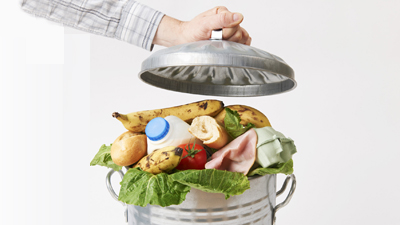
|
|
|||
 CEO Article Spotlight
"You Can't Manage What You Can't See" was written by SCI's CEO Bill Schwartz and featured in The Bottomline Magazine. Bad things happen in the dark and the food and beverage department has a number of places where it's simply too dark to see what's going on. Trash cans, drains, bottoms of containers and closed boxes are just a few of these places. |
 Boot Camp on the Road 2017As the new year approaches, we are starting to plan for our Boot Camp seminar and want to hit the road again in 2017! We are anxious to hear where our clients would like to have the seminars held and welcome any suggestions on locations we should consider. Interested in hosting the seminar? Let us know! Fill out the form below to submit your own location for one of our 2017 on the road dates. Read more.... |
||

FOOD-TRAK Referral Program
The FOOD-TRAK Referral Program has been designed to reward our existing users for their assistance in spreading the word about the many benefits of the FOOD-TRAK system. We know that many of you have relationships with colleagues at other organizations similar to yours and to show our appreciation for your efforts, the program will award a $250 cash bonus for every sale completed as the result of you referral. |
 Tech CornerHaving a problem with duplicate items in your database? You're not alone! Database integrity is the key to having accurate reports and up to date costs. If you are thinking about cleaning up your database, here are some tips. Identify the duplicate items in your database by asking yourself a few questions. Is the item used in a recipe? Is it being inventoried? Is the item used on PO's and invoices? Do I transfer the item or enter it on a waste form? Read more.... |
||
 CEO Article Spotlight
CEO Article Spotlight

Bad things don't happen as frequently in broad daylight as they do in the dark. Casinos go to great lengths to "see" what's going on in the building, and security officers have bad dreams about what could happen if the lights went out. Even the cameras are routinely called "eyes" in the sky. We need to be able to see in order to be able to manage.
Unfortunately, the food and beverage departments have a number of places where it's simply too dark to see what's going on. Trash cans, drains, bottoms of containers and closed boxes are just a few of these places. Developing methods for "seeing" what happens in these places leads to improved food and beverage cost control.
Trash Patrol
"Many years ago when I was working Room Service in a Las Vegas casino, the F&B Director walked into the kitchen and dumped a full trash receptacle onto the floor", relates Tim Hicks, Director of Food and Beverage for Augustine Casino in California. "At the time, I thought to myself, this guy is a total idiot. We were extremely busy and the trash made a tremendous mess. The contents were thoroughly searched and there were several items he found that were discarded. Among the trash was silverware, individually wrapped condiments, an oil cruet as well as an unpaid guest check." Tim now makes it a habit to occasionally check the trash to "see" what's there, and uses that knowledge to take the appropriate steps.
The concept of dumping the trash is not new. One chain restaurant client routinely employed a "Trash Patrol", consisting of two staff members who traveled from store to store dumping out and inventorying trash cans. By looking at the trash, they were able to identify various theft, waste and overproduction issues. The store manager would shortly thereafter receive a report from the corporate office based on the trash inventory, suggesting changes to production levels, security and identifying other steps to help better manage the operation's costs.
Consistent with the idea of being able to see in order to manage, some operators now use clear trash bags hanging in wire frames, as opposed to the traditional approach of trash cans with (or without) opaque liners. Not only does it allow for a quick survey when walking by, it also discourages excess waste and outright theft. Every operator has heard about or witnessed theft by employees placing things in the trash and taking the trash out to a car in the parking lot instead of the dumpster, or picking it up from the dumpster later.
Waste Not, Want Not
Once something goes down the drain, the only people likely to see it work at the water treatment plant. And those folks aren't the least bit interested in identifying the stuff they see. On the other hand, it is amazing how much can be learned about waste if it were only possible to identify what went down the drain. For example, one hotel client was showing a huge variance in egg usage each month. Of course, eggs are not typically over-portioned or stolen, and they don't get casually consumed by kitchen staff during their shifts. After implementing waste sheets, the kitchen manager discovered that the staff was dumping out a batch of egg wash (used for French Toast and other products) every night. The end result was a loss of over 1,000 eggs per month!
Armed with information about what's going down the drain, managers can determine whether to reduce batch sizes, change production schedules, or take other actions to solve the problem. Without the variance information, nobody would know a problem even existed, and without the waste sheets they would have to guess where the variance was coming from. In fact, the waste sheet alone would have pointed out the problem in this case, and would probably have lead to actions resulting in a reduction of the loss.
Tim Julius, Assistant Food and Beverage Director at Tulalip Casino and Resort in Washington is an ardent fan of waste sheets and other similar tools. "I use waste sheets to help me identify specific waste problems as well as patterns of waste." says Tim. "I also use the waste sheets to monitor our progress in reducing waste. In addition, we use daily production sheets to determine leftover quantities. Once we identify these items, we can develop plans for utilizing them properly. Through the production sheets we can communicate daily adjustments to insure we are operating cost effectively."
The prep area is another major source of excess waste. Prep waste typically ends up in a trash can or down the drain. Either way, it is hard to see the trim, and therefore hard to manage it. Kitchen managers make a point of watching people in the prep area to determine if there is any excess trim. Unfortunately, this type of "seeing" requires someone to be standing there. While there is no substitute for the MBWA (management by walking around), approach, there are times when managers simply cannot be present to see what is happening.
One successful approach is to utilize clear Lexan bins in the prep areas. Instead of discarding trim in a trash can or down the drain, prep staff can be directed to place all trim in the Lexan bins. When managers make their rounds, they can examine the bins to "see" if any excess trim has occurred. Only after the bins have been checked can they be emptied into the trash. Excess waste problems can be more easily identified using this practice, and the responsible individuals are standing right there! Steps can immediately be taken to recover anything salvageable, and instruct the prep staff on the proper approach.
Allowing Others to See
Up to this point, the focus has been on what managers can do to help them see problems. Every bit as important, however, is making sure the staff can "see" what is expected of them as well. With the possible exception of psychics, few can see what knowledge lurks in the dark recesses of the brain. And that goes for kitchen staff as well as management.
Studies have shown that adults don't learn as well with their ears as they do with their eyes. Posting instructions, educational materials, recipes, cooking procedures, storage techniques and other useful information can help the staff see what management wants them to know.
For example, posting batch recipes and trim guidelines in prep areas improves the odds that prep staff will avoid costly mistakes. Too many kitchens rely on hands-on instruction as the primary tool for kitchen staff training. In many cases, written recipes are nowhere to be found, even though dozens of people are responsible for knowing them.
One way to "see" the effectiveness of training and gauge individual knowledge retention is to test staff on things they are supposed to know. Handing out a pop quiz in the kitchen with questions like "How much turkey goes into the club sandwich?" and "What is the recipe for a batch of tuna salad?" can be very enlightening. The quiz can help managers "see" the current knowledge level of their staff. Without the quiz, managers can only guess what information has been retained by the staff. Of course, if the answers to these questions were posted on the walls, the staff could "see" what's in the dark recesses of the manager's brain as well.
When it comes to reducing waste, theft, over-prep and other losses, the immortal words "Let There Be Light!" can have new meaning. Perhaps that banner should be posted over the manager's desk.
 Development News
Development News
New - Community Forum. The Community Forum on the Client Support Center is a place for clients to post questions to other users, collaborate, share ideas with each other and build relationships with other FOOD-TRAK clients. The Community Forum is moderated by SCI, so you can always expect a response and potentially get feedback from other users who have experienced a similar issue. SCI is looking forward to using this new method of communication to reach more of our users and are eager to hear what you have to say. Join the online discussion and begin posting your own questions!
 New FOOD-TRAK Referral Program
New FOOD-TRAK Referral Program
The FOOD-TRAK Referral Program has been designed to reward our existing users for their assistance in spreading the word about the many benefits of the FOOD-TRAK system. We know that many of you have relationships with colleagues at other organizations similar to yours and to show our appreciation for your efforts the program will award a $250 cash bonus for every sale completed as a result of your referral.
See the brochure.
 Tech Corner
Tech Corner
Having a problem with duplicate items in your database? You're not alone! Database integrity is the key to having accurate reports and up to date costs. If you are thinking about cleaning up your database, here are some tips. Identify the duplicate items in your database by asking yourself a few questions. Is the item used in a recipe? Is it being inventoried? Is the item used on PO's and invoices? Do I transfer the item or enter it on a waste form?
If you are having a hard time finding an item because it doesn't follow a specific naming convention, have duplicate items or old items that are no longer purchased, inventoried or used in recipes, we would encourage you to consider cleaning up the database. To get started, identify a naming convention for all items that will be used moving forward and avoid using brand names, pack sizes and punctuation. Edit any existing items in your database so that they too follow this new naming convention.
For duplicate items, we recommend keeping the item with the most purchases since this item will have the most current information. Run either a Purchase Recap or Price History report for the past year and isolate the items with duplicates. Once selected, you will have to swap out items on invoices (along with other forms they may be entered on) that you want to delete with the item you want to keep and then re-complete the form to save your changes. For those items you wish to delete from your database, edit the name of the item by putting a "z" in front of the item name so it will appear at the bottom of the item list and then delete in mass through the selection function. You could also choose to inactivate an item and restrict it from appearing on reports. For a more detailed approach on the database cleanup process, please consider taking the FOOD-TRAK University course Database 102: Purchased Items.
 New FOOD-TRAK Test Drive
New FOOD-TRAK Test Drive
Explore a wide variety of functionality within the FOOD-TRAK System, check out the latest version or use the Test Drive as a way to train users on how to use the software. A demonstration database has been provided for each session, which is limited to 20 minutes. No technical support is available for this site as it is strictly to be used as a self-training tool and some features may not be available for technical reasons. Click here to experience the Test Drive.
University Course of the Month
 Database 102: Purchased Items
Database 102: Purchased Items
This is an excellent course to introduce new and existing users to some of the best practices for attaining a clean database. Since the database is essentially the nucleus of your FOOD-TRAK System and critical to the accuracy of reporting, this course takes the user back to the basics to ensure integrity within the data itself. The training provided in Database 102 will help you identify any weaknesses in the current structure of the existing data and show users how to properly maintain the database moving forward. This course demonstrates how to create and edit vendors, set bid preferences, establish delivery dates and terms and vendor interface integration. It also covers adding Items to the database, editing Unit information and setting Item associated costs.
Click here to access the FOOD-TRAK University Course Catalog.
Welcome New Clients
Hilton Los Angeles - Universal City
Los Angeles, CA
Vivo Kitchen
Apple Valley, MN
Boot Camp 2017
January 24 - 27 Scottsdale, AZ | March 14 - 17 Richmond, VA | April 18 - 21 Scottsdale, AZ
As the new year approaches, we are starting to plan for our Boot Camp seminar and want to hit the road again in 2017! We are anxious to hear where our clients would like to have the seminar held and welcome any suggestions on locations we should consider. Interested in hosting the seminar? Let us know! Fill out the form below to submit your own location for one of our 2017 on the road dates.